
COVID-19 has had a tremendous impact on the business landscape, and because of this, virtually everything has been disrupted. Business models, technologies, agile work, leadership capacity, and employee attitudes have evolved and are changing the way organizations work. And the employee’s role in supporting these changes has never been more important. But when it comes to understanding employee perceptions about company culture, most organizations are woefully out of touch. In a recent IBM study, only 50% of employees feel their organizations understand their needs and have their best interests at heart.
Compounding issues that organizations are facing is the emergence of a workplace phenomenon called the “Great resignation.” The phrase refers to the roughly 33 million Americans who have quit their jobs since spring 2021. And while sources expect the trend to slow down in 2022, its presence is escalating issues of employee retention and the war for talent in the workforce.
In light of this, the researchers at The Employee Work Passion Company teamed with Training magazine to launch a two-part study to understand how employee perceptions of their organizations have shifted in the last few years and especially in face of the COVID-19 pandemic. The first study was launched in 2012 and examined perceptions regarding 12 dimensions that influence Employee Work Passion, a highly engaged state of performance that represents the upper realm of employee engagement. The second study, launched in 2021, examined the current perceptions of respondents of their work environments and compared them to responses from the first study to understand how those perceptions had shifted in the last 10 years and especially during the presence of COVID-19.
Methodology and Demographics
The assessment utilized was The Employee Work Passion Assessment, which includes 12 subscales representing, Organization, Job, and Relationship dimensions and the degree to which they exist in an organization’s culture. Each subscale has three statements, and responses for each subscale are aggregated to represent a summated total. The assessment also includes five subscales that measure intentionality (how an individual intends to behave as a result of their assessment of the organizational culture). The assessment utilizes a 6-point scale with response possibilities ranging from “to no extent” to “to the fullest extent.” Aggregated totals have a numerical range from 3 to 18, with 18 being the highest possible score. The theoretical midpoint for each subscale is 10.2. All differences reported are statistically significant at the .05 level. Some 668 people participated in the 2012 study, and 695 participated in the 2021 study.
The demographic breakdown for the 2021 study was:
Gender: Males 32%, females 68%
Age: Baby Boomers 65%, Gen X 19%, Gen Y 16%
Level: Managers 32%, Directors 27%, Supervisors 12%, Senior Managers/VPs/C-Level 23%, Other 7%
Survey Findings
The assessment measured 12 subscales that are organized by Organizational, Job, and Relationship Dimensions, as well as five subscales that measure performance Intentions.
ORGANIZATIONAL DIMENSIONS
Organizational dimensions are attributes that are influenced by the organization’s senior leadership strategies, policies, procedures, and organizational systems and how these elements impact growth opportunities, perceptions of fairness, and the extent that employees have a clear understanding of what’s expected of them at work. They include:
- Growth: Employees perceive that the organization fosters opportunities for both career and job growth.
- Procedural Fairness: Employees perceive decisions as being fair and equitable with equal application of rules for everyone.
- Distributive Fairness: Employees perceive an equal input-to-output ratio of effort to reward.
- Performance Expectations: Employees perceive that work outcomes are to be done to a certain level of quality and quantity.
Compared to the 2012 study, each dimension dropped between 1 and 2 points in 2021. All of these are statistically significant, except for Performance Expectations.
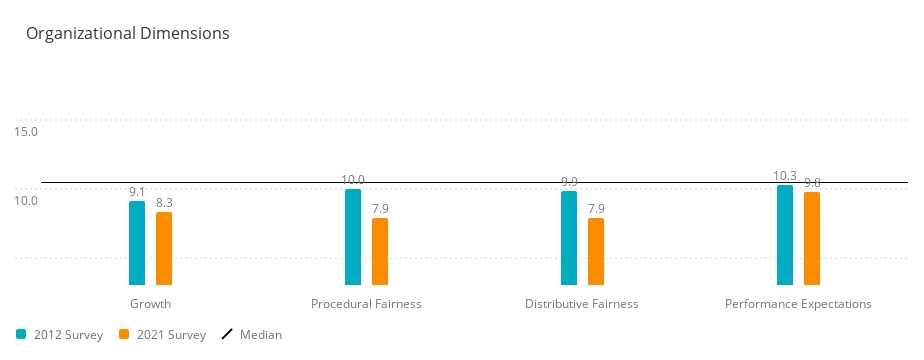
RELATIONSHIP DIMENSIONS
Relationship dimensions influence an individual’s perception of their relationships with their leader and their colleagues, as well as their perceptions of whether collaboration is encouraged in the organization and the quality of the feedback they receive from their leaders.
- Collaboration: Employees perceive that there is cooperation and teamwork within a work unit and/or across work units within the organization.
- Feedback: Employees perceive an environment where they receive timely, relevant, and specific information regarding their performance.
- Connection with Leader: Employees perceive they have a supportive and personal relationship with their leader.
- Connection with Colleagues: Employees perceive they have rewarding interpersonal interactions with coworkers.
Compared to 2012, all four dimensions are 2 to 3 points lower in 2021, and all are statistically significant.
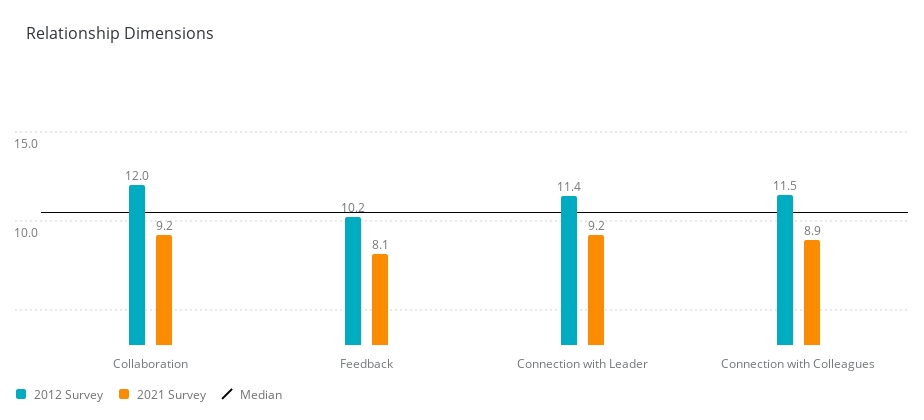
JOB DIMENSIONS
Job dimensions are influenced by aspects of the job, colleagues, or leader and include perceptions around levels of autonomy, the extent to which employees feel the work they are doing has meaning for the organization, and perceptions of the current workload and variety.
- Autonomy: The extent to which employees feel empowered to make decisions about their work and tasks, and in control of their work and their ability to achieve their goals
- Meaningful Work: The extent to which employees perceive their job actions are important inside and outside the organization and have lasting worth for themselves and others
- Task Variety: The extent to which employees perceive that the work they do is different enough to meet their motivational needs
- Workload Balance: The extent to which employees perceive that their workload is reasonably proportioned for the time they have to accomplish it
Compared to 2012, all four dimensions are down in 2021 by 2 to 3 points, and all are statistically significant.
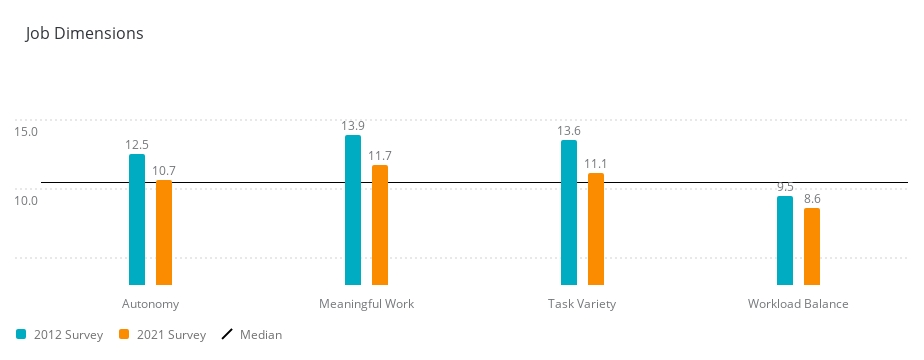
THE 5 INTENTIONS
An individual’s intentions are driven by their perceptions and appraisals of their environment. Based on their appraisals, employees form judgments (appraisals) about what they intend to do as a result of what they think and feel about what is happening in their work environment.
The five intention scales include:
- Discretionary Effort: The extent to which the individual intends to expend their discretionary effort above and beyond agreed-upon requirements on behalf of the organization
- Intent to Endorse: The extent to which the individual readily endorses the organization to others as a good place to work and as a quality supplier of goods and services
- Intent to Remain: The extent to which the individual plans to stay with the organization
- Intent to Perform: The extent to which the individual intends to do their job well and work effectively to help the organization succeed
- Organizational Citizenship Behaviors: The extent to which the individual is committed to supporting fellow workers and behaving in ways that are respectful, considerate, and sensitive to others
Compared to 2012, all five intentions are down between 2 and 4 points, and all are statistically significant.
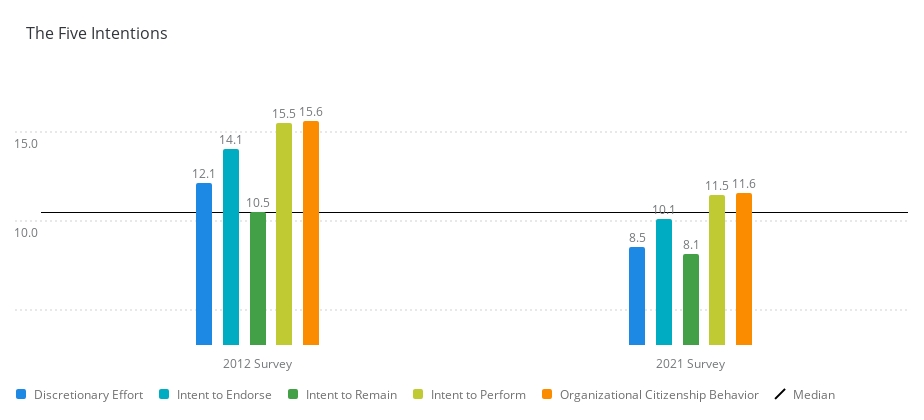
We also were interested to learn which of the dimensions had the most influence on an individual’s intent to remain with their organizations. The top four answers were Meaningful Work, Growth, Autonomy, and Distributive Fairness. People want to feel like the work they do matters and that they are working for an organization that has a purpose beyond simply making money. They also want to feel like they are working for an organization where they have opportunities to learn and grow in their current roles but also that there is a clear career path that has been discussed with them. They want to have some level of decision-making and autonomy in their current roles and know they are trusted to accomplish certain tasks without being micro-managed. Finally, they want to feel like they are working for an organization where rewards, compensation, and recognition are commensurate with the amount of work they accomplish.

We also asked respondents to tell us who they felt had the responsibility to impact each of the top four dimensions. Regarding Meaningful Work, almost 50% of respondents felt it was their responsibility rather than that of their immediate leader or senior leadership. In regard to Autonomy, respondents felt like the responsibility was both theirs and their immediate leader’s, with the scales tipping slightly toward the leader. In regard to Growth, respondents indicated that the responsibility should be shared among themselves, their leader, and senior leadership. And regarding Distributive Fairness, respondents felt the majority of the responsibility should fall to senior leadership. This data is consistent with the data collected in 2012, where individuals saw themselves taking the lead on creating a sense of Meaningful Work, a secondary role in creating Autonomy, and a shared role in creating Growth opportunities, while they felt Distributive Fairness was primarily the responsibility of senior leaders.
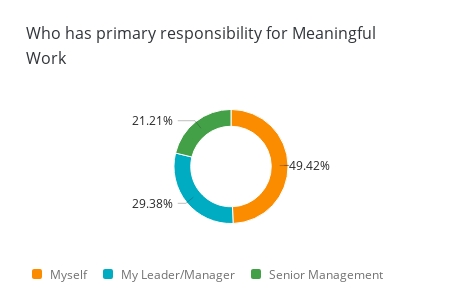
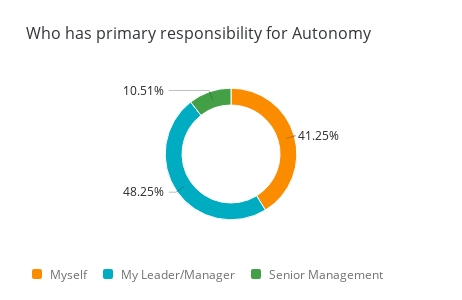
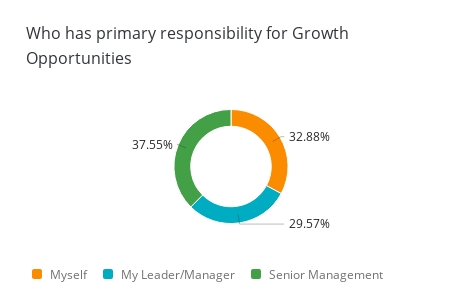
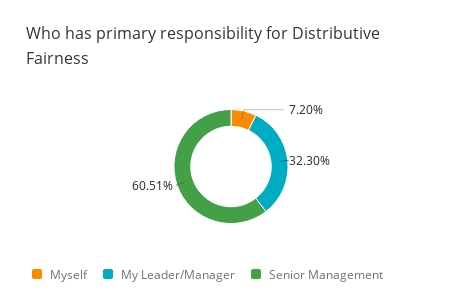
The Organizational Sweet Spot
There is a high degree of correlation between the 12 dimensions and the 5 intentions. This can vary from organization to organization depending on a variety of dimensions that are either present or not in the culture of the organization. For the purposes of this study, we ran a regression comparing the strength of the relationship between the dimensions and the intentions. The regressions fell into four groups:
- Dimensions that are highly correlated to influencing the dimension positively and the organization is already doing a good job in regard to that dimension
- Dimensions that are highly correlated to influencing the dimension positively, but the organization is not doing a good job in regard to that dimension
- Dimensions that are not highly correlated to influencing the dimension positively, but the organization is already doing a good job in regard to that dimension
- Dimensions that are not highly correlated to influencing the dimension positively, and the organization is not doing a good job in that dimension
In each comparison, we gleaned insight into the areas where organizations excelled and where there was room for improvement.
- In regard to improving Intent to Perform, there were three areas of influence that organizations were performing well at: Collaboration, Connections to Leader and Performance Expectations. We found that the two areas that organizations could improve upon included Connection to Colleagues and Feedback.
- In regard to improving Discretionary Effort, the areas where organizations are performing well were Collaboration, Connection to Leader, and Performance Expectations. We found two areas that organizations could improve upon: Connection to Colleagues and Feedback.
- In regard to improving Organizational Citizenship, the areas where organizations are performing well were Collaboration and Connection to Leader. We found three areas that organizations could improve upon: Connection to Colleagues, Feedback, and Procedural Fairness.
- In regard to improving Intent to Endorse, the areas where organizations are already performing well included Collaboration and Connection to Leader. We found three areas organizations could improve upon: Connection to Colleagues, Feedback, and Procedural Fairness.
- In regard to improving Intent to Remain, the areas where organizations are already performing well were: Connection to Leader and Collaboration. We found three areas organizations could improve upon: Connection to Colleagues, Feedback, and Growth.
The Big Three
For the purpose of this study, we ran a regression analysis to understand the strength of the correlations between the 12 dimensions and the 5 intentions. The regression showed that three dimensions emerge as having a high degree of correlation or importance in regard to influencing all five intentions and yet respondents don’t currently see their organizations doing a good job in these areas. These include:
- Connection to Colleagues, which correlated to all five intentions
- Feedback, which correlated to all five intentions
- Procedural Fairness, which correlated to three of the five intentions
Connectedness with Colleagues
Just as a solid relationship with one’s leader influences Employee Work Passion, so do strong relationships with colleagues and coworkers. Individuals want to have a personal connection with their coworkers in addition to a professional work relationship. Because there is a human need to connect, individuals want to care about others, and they want others to care about them. When these conditions are present in the work environment, an organization can look forward to several desired work outcomes, such as improved organizational commitment, increased job satisfaction and performance, decreased turnover, and a better sense of employee well-being. Improving a sense of connection among colleagues often can start with quality conversations.
For Individuals:
- Identify your current level of Connection with colleagues in your work unit.
- Look at your best work relationships and identify some of the dimensions that contribute to it.
- Get involved in more activities. What groups can you join?
- Talk with coworkers about interests outside of work. Ask questions about hobbies, sports, and leisure activities.
For Operational and Strategic Leaders:
- Provide opportunities for people to work together on group projects.
- Recognize personal achievements and milestones such as birthdays, anniversaries, and graduations.
- Share appropriate personal information about yourself so others can see a different side of you beyond your work role. Encourage others to do the same.
Feedback
Effective feedback has a significant impact in the arena of Employee Work Passion in that it shows a strong correlation with favorable outcomes such as organizational commitment, job satisfaction, role performance, intention to remain, intrinsic motivation, pay satisfaction, and reduced absenteeism. When individuals receive meaningful, effective feedback in a non-threatening way, they are more highly motivated, generally find greater satisfaction in their work, and their performance improves. Leaders and organizations should consider the following ideas in regard to improving feedback within their organizations:
For Leaders:
- Practice giving feedback with a peer to understand how your words and delivery style are received by others.
- Give feedback in a timely fashion so it can be most effective.
- When receiving feedback, ask for clarification if it is not specific enough to be actionable.
- Understand that accurate, meaningful feedback can be your best coach for helping you become a star.
For Organizations:
- Train leaders to make good use of feedback for education and understanding rather than corrective action only.
- Encourage leaders to catch people doing things right and acknowledge it publicly.
- Foster a culture where contributing new ideas is welcome and recognized.
- Encourage senior leadership to model best practices regarding feedback
Procedural Fairness
Employee perceptions and judgment of their organization’s Procedural Fairness often centers on certain features of the decision-making process, such as the level of employee voice, the appropriateness of evaluation criteria used in the decision-making, and the accuracy of the information used to render a decision. Usually, an employee’s perceptions of the organization’s procedural fairness focuses on the organizational policies and procedures rather than on a specific individual or leader behavior in the organization; however, employees also tend to observe how their leader treats them as they formulate their perceptions of organizational procedural justice.
For Individuals:
- Talk to your leader about the process under which they may improve their decision-making.
- Ask for more opportunities to be part of the decision-making process before decisions are reached.
- Suggest that anyone who is a stakeholder in the decision should have their interests considered.
- Look for ways to provide decision-makers with strong empirical evidence for your point of view.
For Organizations:
- Establish a clear organizational vision that includes the expressed outcome of being fair and just as an expectation for all employees.
- Establish checks and balances in the decision-making process that require all stakeholder interests be considered before decisions are reached.
- Establish a process through which grievances and perceived injustices can be aired and resolved.
- Recognize and publicize people who stand up to speak their truth in a way that is respectful and helpful to finding the best solution for all.
Conclusion
Clearly, respondents’ perceptions of their work environments have shifted significantly in the last decade. Eleven of the 12 dimensions we measured are significantly lower in 2021 when compared to 2012. All 5 intentions were significantly lower, as well. We believe that at least part of this shift can be linked to COVID-19, which has dramatically changed the way we work and socialize. While many individuals may appreciate the opportunity and flexibility of working from home, COVID-19 also has created a sense of isolation. Connection to Colleagues, Collaboration, Feedback, and Connection to Leader are much lower in 2021 than in 2012, which points to a loss of community and potentially less access to information—all of which can create higher levels of stress and uncertainty.
As individuals and organizations attempt to navigate the new normal in regard to working remotely full or part time, as well as other challenges linked to COVID-19, it’s important to focus on ways to create meaningful connections in our daily routines, to the work we do, and to the practices and people who are important in our lives.
The Employee Work Passion Assessment (EWPA) provides organizations with an easy and reliable way to understand the strengths and weaknesses of their current corporate culture. It measures the Organizational, Job, and Relationship dimensions; key work intentions; and employees’ assessment about how they feel about their jobs.




